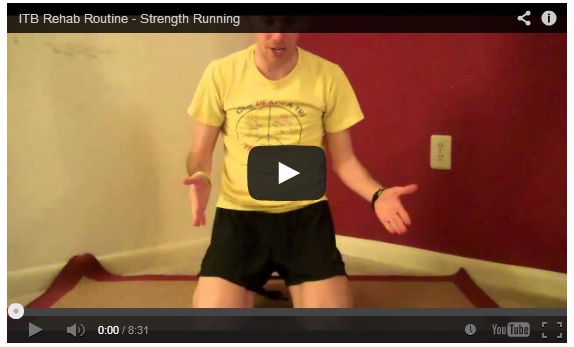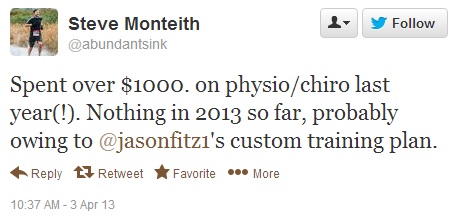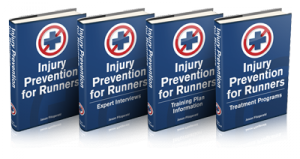There’s something I haven’t told you: treating my IT band syndrome didn’t just revolve around the ITB Rehab Routine.

Effective IT band syndrome treatment is much more involved than doing a 10 minute strength routine a few times a week. Sure, this routine was instrumental in getting me healthy. And it’s helped literally thousands of other runners, too.
But it was just a piece of my overall ITBS treatment.
I created the routine after seeing four physical therapists and exhaustively researching IT band syndrome. Hundreds of people have told me it’s almost an exact replica of what their physical therapist prescribed – and they could have saved hundreds or thousands of dollars if they found it first!
These notes make me happy; I love coaching so you can avoid my mistakes and learn what really works. Messages like these make my day:



But the routine I developed is just that: one routine. It’s not a program or a specific treatment protocol. The ITB RR was also tailored to me back in 2009 – the particular exercises I needed, including how many repetitions for each one.
I shared the routine so runners could use it as part of a treatment program (or simply as prevention). And two years later that video has been viewed over 115,000 times, shared thousands of times, and has nearly 200 comments. It’s my second most popular post ever.
But the comments show most runners don’t know how to get healthy. Here are a few:
Do you recommend a foam roller to stretch the IT Band? (you can’t stretch the IT Band – yes, use a foam roller but not on the IT Band itself)
Does the specific thickness of the foam roller matter? What about cryotherapy? (no and no)
I fought ITBS for a while, ended up changing shoes and was put in custom orthotics. Then I was told to get a stability shoe to further correct my over-pronation. Is this going to help? (unlikely)
Most runners don’t treat injuries systematically. Instead, they use the Try Everything, Try Nothing approach and throw a bunch of treatments against the wall to see what sticks.
Inevitably, they say things like “I’m 4 months into my recovery with daily stretching, foam rolling, and rest with no progress.”
I’m not surprised.
IT Band Syndrome Treatment Is About the *Mentality* to Recover
Before recovering from any injury, ask yourself if you’re ready to recover.
When I was injured for six months in 2008, I went through an intense period of denial. If you’ve been injured, you’ll recognize my thought process:
There’s no way this injury is that serious.
I’ll just rest and see how it feels in a week.
If I just do what I’ve always done, this will go away on its own.
I’m losing so much fitness – I’m going to have to start from scratch!
Mentally, I was in a horrible place. I knew deep down that my IT band was severely hurt, but I thought “waiting it out” was the best ITB treatment.
In fact, I planned a 5k race over Thanksgiving just two weeks after my injury. It never happened. Soon a week turned into a month. A month turned into three months.
Feelings aren’t something I openly write about here but I was depressed. It was the middle of winter – cold, dark, and I couldn’t even go for a run to lift my spirits. Instead, I sat on the couch and watched reruns of House while eating an absurd amount of ice cream. I should have bought stock in Ben & Jerry’s.
I wanted to be healthy and pain free more than anything. I’m sure you felt the same way during a previous injury.
Three months of lethargic self-loathing later, something snapped and I desperately searched for an effective IT band syndrome treatment. The motivation to get healthy is what finally pushed me to do something about my injury. I wasn’t content to sit on the couch any longer and wait for some mythical day to arrive where my knee wouldn’t hurt.
My injury needed a more proactive approach (most do). I started researching physical therapists in the area and made appointments. After seeing four of them, I found one who understood running and ITBS, but more importantly understood that I was a runner and needed to get back to running as soon as possible.
His goal was straight-forward: get me back to doing what I love. I had three weekly appointments (or put another way, about $100 worth of physical therapy every week).
Once I fully committed to recovery, my injury improved dramatically. It no longer hurt to walk and most days I felt 100%. I went from being depressed and in denial to optimistic and encouraged. I knew that I was going to get healthy.
I believed in my IT band syndrome treatment. Not only that, but I was fixing lifestyle mistakes that contributed to my injury. Running was in my future!
I’m telling you this because sometimes we focus too much on the specific exercises and don’t take a step back to look at the whole picture. Having the right mentality is crucial to overcoming ITBS (or any injury). As corny as “stay positive” sounds, it’s absolutely true.
As exercise science journalist Alex Hutchinson (and expert interviewee in Injury Prevention for Runners) wrote on Sweat Science:
“When athletes begin to doubt themselves… it can spin into a self-fulfilling spiral of failure.”
If you believe you’re destined to stay injured, you very likely might stay injured. But by getting rid of those negative beliefs, like I did, you can help yourself finally get healthy.
I recently interviewed Ariana Hilborn (a pro runner in Phoenix who didn’t even start running until 2007!) for the Injury Prevention for Runners program. Last fall she experienced her first significant injury. But her mentality was critical to her recovery.
She said things like,
I am not throwing in the towel. This will pass and make me stronger and even more motivated to accomplish all of my running goals. Just a little hiccup.
I love when runners stay positive, believe in themselves, and recognize that injuries have the potential to actually improve your running if you handle them the right way. Of course we want to stay healthy. But if you do get injured, use it as a learning experience.
Getting (and staying) Healthy is a Process
Injuries are best treated systematically with a program that treats both symptoms and causes of your injury. If you don’t know WHY you’re injured, you won’t be able to treat it effectively.
Once I learned that ITBS won’t be cured by rest, ice, or stretching I got to work on IT band syndrome treatments that actually work. I focused on strength exercises, form improvements, and lifestyle changes that improve the healing process.
These are the same strategies I now use with runners who buy custom rehabilitation programs for ITBS and those who were in the 1-on-1 Injury Prevention Coaching program. And you’ll get the step-by-step process for healing injuries like runner’s knee, ITBS, Achilles tendinopathy, and plantar fasciitis.
This information is available to you in Injury Prevention for Runners – the most comprehensive prevention product currently available.
Unlike the random tips and questionable advice you’ve seen on the web, this program uses the best prevention and treatment protocols available.
I’ve spent nearly two years and thousands of dollars researching injury prevention so you don’t have to – you can just get back to doing what you love (running!).
Needless to say, I’m beyond excited to share this with you. Those on my Injury Prevention email list have gotten extra information (you can sign up here to get that bonus content) like several presentations on how to stay healthy.
Stay healthy and run strong!